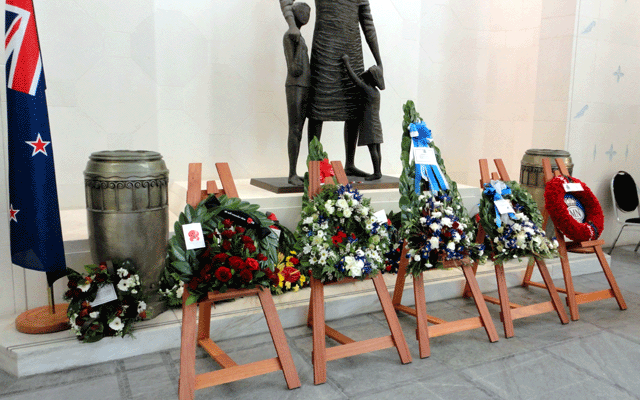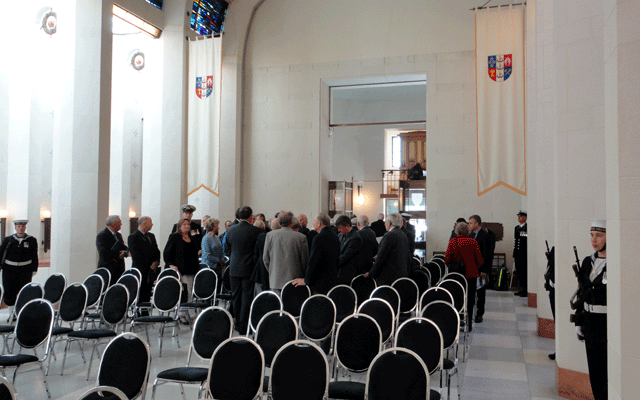Merchant Navy Day was celebrated in various ports today 03 September 2011. In Wellington the service was arranged by the Department of Internal Affairs and was held at the National War Memorial which has limited seating. The official party included Hon Dr W Mapp representing the Government, Ian Dymock representing the Merchant Navy Association and members of the Diplomatic Corps.
Master Mariners were represented by Captains Ron Palmer, Graham Williams, Peter Attwood, Ifor Owen, John Brown, Lew Henderson, Mike Pryce, Tim Nicol and Kees Buckens from Auckland who was also representing the Nautical Institute.
The following Prologue was read by Rear Admiral David Ledson Chairman MNZ, Chairman National War Memorial Advisory Council
Today is New Zealand’s second Merchant Navy Day – a day that recognises the serviceof merchant Sailors in the past – and especially in the two World Wars. However, it also acknowledges the important contribution that the ‘Merchant Navy’ continues to make these many years later to the prosperity and security of our country.
Two historical facts are especially relevant to Merchant Navy Day.
ln the First World War around 14,661 merchant seamen lost their lives. ln honour of this sacrifice King George V granted the title ‘Merchant Navy’ to the service in 1922. Prior to this it had been referred to variously as the Mercantile Marine, the Merchant Service or the Merchant Marine.
September the 3rd is the chosen date for Merchant Navy Day because it was on that date in 1939 that the first merchant ship casualty of the Second World War occurred – when SS ATHENIA was struck by torpedoes fired from the German U-Boat – U30.
The Veteran Merchant Mariners whom we especially acknowledge and honour today are not bound by a common birthplace – some were born in New Zealand – and others overseas, including in the United Kingdom and Australia. What binds them is their shared experience of life at sea- across the world’s oceans – in the Second World War.
The convoy battles of that War were as bitter and terrible in their own way as any other – but they were fought largely out of the sight of landsmen – what one does on land is evident, what one does at sea leaves no evidence.
Consequently, the vitally important role played in the Allied victory by the ships in those convoys is sometimes overwhelmed by the stories of Allied efforts on land.
Nonetheless, the historical reality is that while the Navy, Army and Air Force may have provided the fists that fought the enemy into submission, the Merchant Navy played a crucial role in supporting the sinews and muscle that sustained the physical effort.
Each of the main sides in the Merchant Navy’s battles of the Second World War paid a high price- one for defeat and the other for victory.
While German U-boats sank around two thirds of the total allied tonnage lost – it was at the cost of 793 U-boats and some 28,000 submariners; 75% of those who served in U-boats during the war. On the Allied side, around 4, 7OO merchant ships were sunk and some 30,000 merchant seamen were killed aboard convoy vessels,
About 130 of those men who died are known to have been New Zealand merchant seafarers -and in the words of New Zealand History Online:
‘The age of some of the victims is striking. As a civilian industry, the Merchant Navy naturally contained employees who were younger or older than those in the armed forces. For centuries,seafarers had embarked on their careers when barely into their teens, typically as deck or messboys, or as apprentices (trainee officers). Fifteen New Zealand teenagers are known to have lost their lives during the war, including Thomas Burke and Edward Walls, two 15 year old deck boys on the Port Hunter, which was torpedoed off west Africa in 1942. These two teenagers were almost certainly the youngest New Zealanders killed in combat during the 20th century”
There is a well-known saying by the poet and philosopher George Santayana which is often used on occasions such as this. ‘Those who cannot remember the past arecondemned to repeat it.’
However, this represents but one view of how we should regard history. There are some events from the past that we need to remember so that we can honour those who were caught up in them – and acknowledge their service to our country – by passing on their stories from one generation to another. So I ask those of you here today who are still directly involved with the ‘Merchant Navy’ – will you pass on the stories of the men of the Merchant Navy of the world wars to the men and women of today’s and tomorrow’s Merchant Navy?.
And, as you contemplate what your answer will be, I ask you to look at the Veterans with us today, and think about what they have experienced and what they have done in relation to this quotation from the Ancient Greek statesman Pericles, “What you leave behind is not what is engraved in stone monuments, but what is woven into the lives of others”.
Finally, to the Veterans – You have written your chapter of the Merchant Navy’s story- its tales are stirring ones and you can be proud of your place in them.
 Wreaths were laid on behalf of the Government of New Zealand, Government of Australia, British High Commision, Federal Republic of Germany, Republic of South Africa, New Zealand Shipping Federation, Merchant Navy Association, Russian Convoy Association, Royal NZ Navy, Royal New Zealand Returned and Services Association.
Wreaths were laid on behalf of the Government of New Zealand, Government of Australia, British High Commision, Federal Republic of Germany, Republic of South Africa, New Zealand Shipping Federation, Merchant Navy Association, Russian Convoy Association, Royal NZ Navy, Royal New Zealand Returned and Services Association.
 Participants departing from the National War Memorial
Participants departing from the National War Memorial
In Auckland Merchant Navy Day was celebrated at Voyager Maritime Museum, for the second time. There were about 150 people in attendance, including members of Master Mariners, Museum personnel and Volunteers and a contingent of Young Mariners. The attendee’s were greeted by John Downie, a Museum Volunteer with his bagpipes.
We were welcomed by Murray Reade, CEO of the Museum and then Reverend Bill Law, President of the Auckland Merchant Navy Association and Honorary Padre to the Auckland Branch of The New Zealand Company of Master Mariners began the service. ‘Eternal Father, Strong to Save’ was the first hymn. Captain John Frankland, Warden of Auckland Master Mariners gave the reading. This was followed by the Seafarer’s 23rd Psalm. Bill Law then talked of his visit, with his wife, to the War Grave site in Singapore. He related how his wife burst into tears at the sight of so many gravestones with “Known only to God” as an inscription. She whispered to Bill “Their Mother’s knew them”. Bill carried on to relate facts about War losses and the extreme youth of all too many of the casualties. One was as young as 14 years and 5 months. The Padre from the Seaman’s Mission conducted a prayer.
The assembly was then moved to the Memorial Plaque in the Ocean’s Apart gallery and the ceremony of dedication of the wreath, which was laid on a table below the Plaque, the Last Post, followed by the ‘Ode’ delivered by Captain Tony Payne, a ‘Lament’ on the bagpipes, ‘Reveille’ and the closing prayer by Rev Bill Law.
Last year was good, considering it was held so soon after the Government’s decision to honour the Day. This year was so much better and the Museum staff had done a great job of promoting the event.
